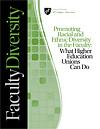Racial and Ethnic Diversity
After generations of activists pushed back against a higher education system largely restricted to affluent white males, the campaign for racial and ethnic diversity in American colleges and universities gathered momentum in the post-World War II era, spurred by court-ordered desegregation, the grass-roots civil rights movement, the resulting Civil Rights and Voting Rights acts, and the Great Society educational opportunity programs. High school completion rates and college enrollment rates for each race or ethnic group for which data is available have improved over the last 20 years. However, African-Americans, American Indians, and Hispanics continue to be underrepresented among those who complete a bachelor's degree and the advanced or professional degrees that are a prerequisite to faculty positions.
Between the years of 1995 and 2011 the number of Ph.D.s awarded to African-Americans and Latinos has more than doubled for both groups, though still not an accurate reflection of the population at large, from a combined total of 5.9 percent to 12.4 percent of those receiving Ph.D.s. Longitudinal data from the Department of Education show that the educational pathway to the Ph.D. begins to narrow from the eighth grade through the end of high school for African-American, American Indian, and Hispanic students.
Potential faculty members from underrepresented racial and ethnic groups may encounter obstacles in their job search because of two national factors that transcend the campus itself: opposition to affirmative action and the national trend away from creating and filling full-time tenure-track faculty positions. Of the only 10.4 percent of faculty positions held by underrepresented racial and ethnic groups in 2007, 73 percent are contingent positions—which means that nearly three-quarters of underrepresented faculty hold positions that do not give them adequate wages or benefits, job security, or meaningful academic freedom.
If they manage to gain entry into the academy underrepresented faculty members may feel tokenized, stigmatized, left out or out of place. In addition, they often cite, as a primary reason for leaving their institutions, an inability to connect with mentors to help them navigate the institutional culture and the demands of their departments and disciplines. In particular, some studies point to the confusion engendered by the tenure and promotion process.
We see the process of effectuating a diverse faculty and staff as an essential element in achieving a greater measure of economic and social justice in America. Our report recommends higher education unions make faculty diversity an important part of their agenda on campus, though this work could be undertaken by other kinds of faculty groups. We believe that unions are uniquely positioned to speak to issues of equity and fairness. This can be done by conducting an inventory to asses the condition of diversity on campus, discussing these conditions with leaders and members, and designating a group of people to coordinate efforts in this area.
To learn more about what AFT recommendations for locals wishing to address racial and ethnic diversity on their campus, read our report.

